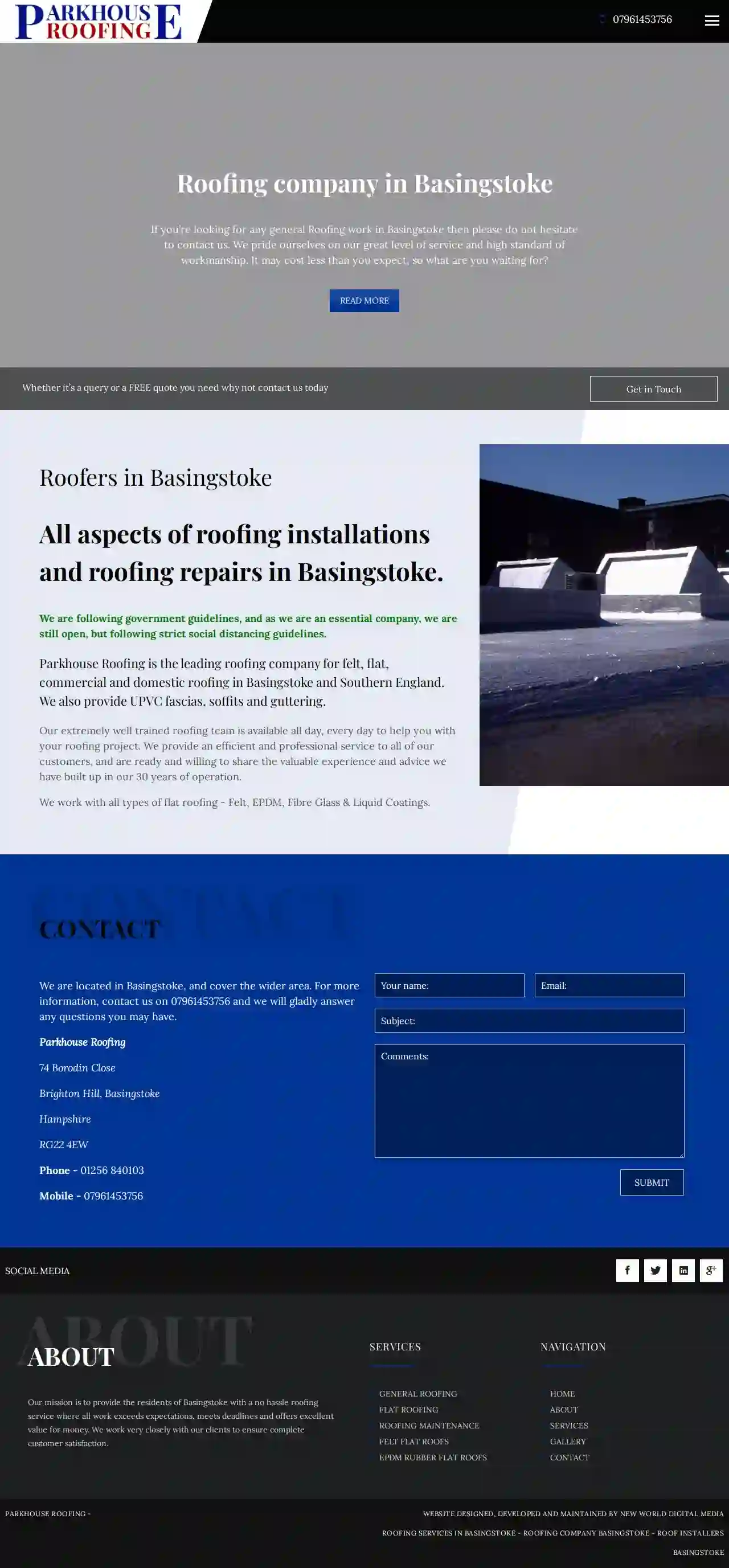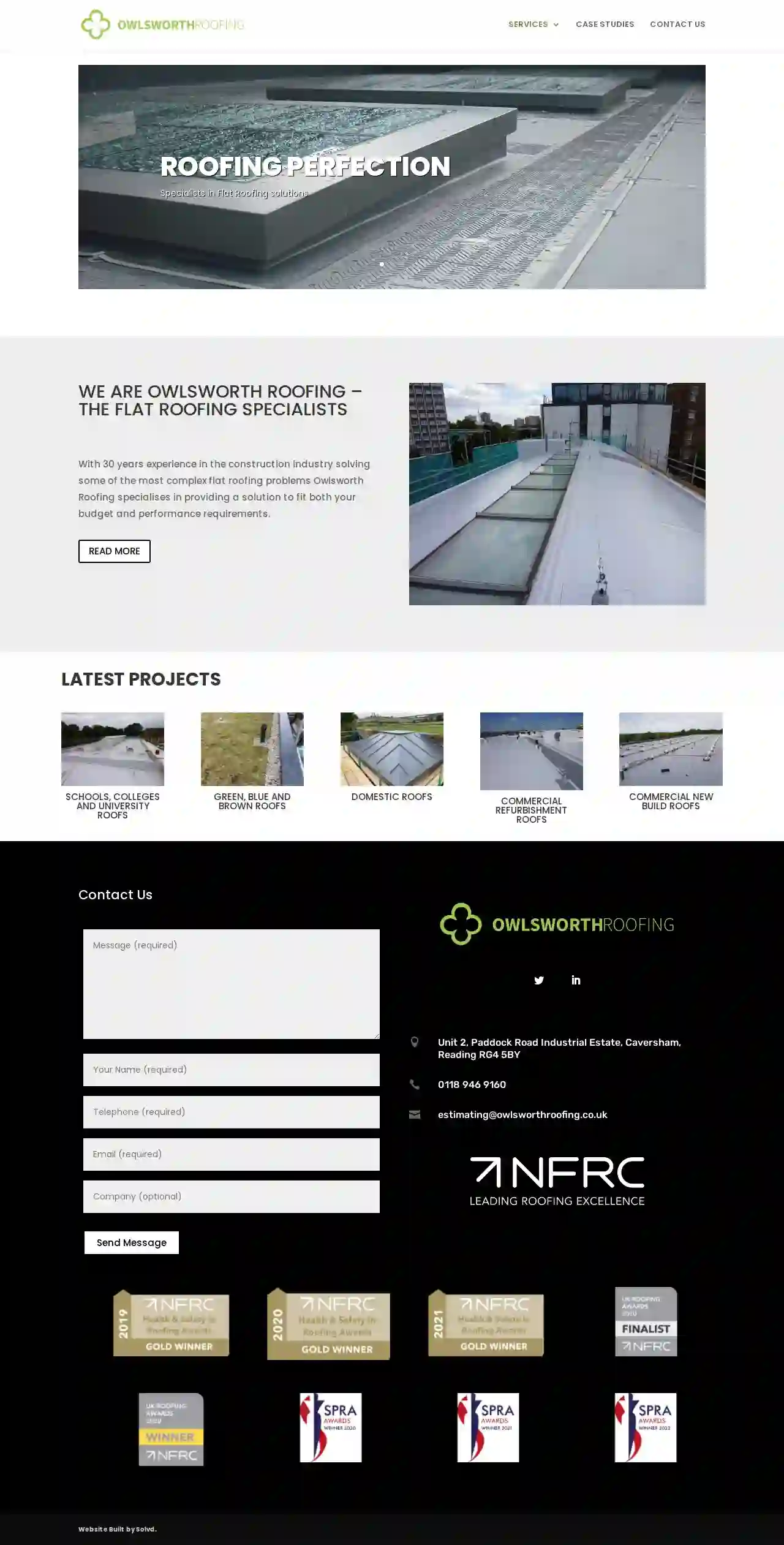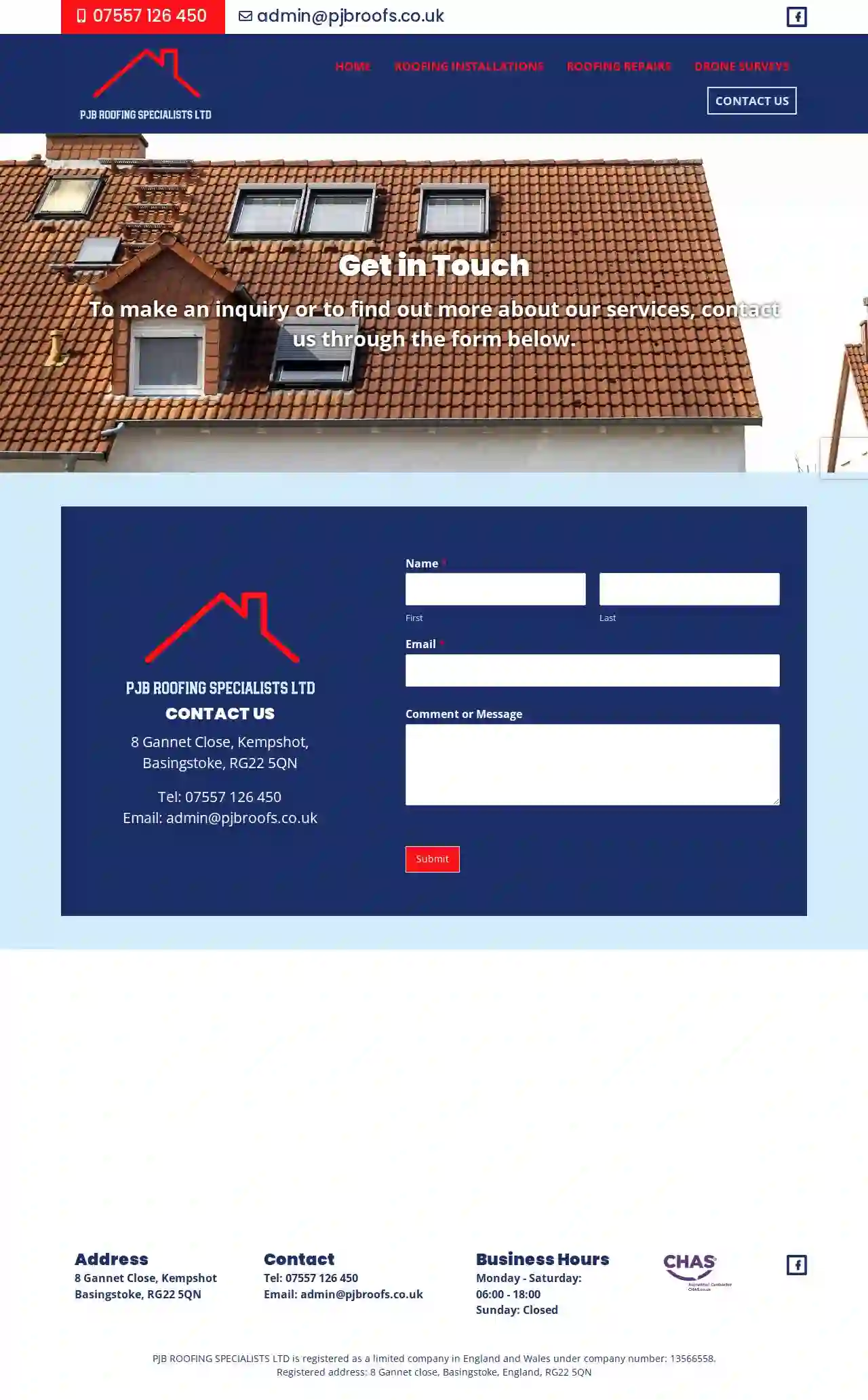Roofing Companies Earley
Find top Roofers in Earley
Get 3 FREE Roofers quotes for your project today! Compare profiles, reviews, accreditations, portfolio, etc... and choose the best offer.

D C Roofing & Building Services
100-102 Chester Road, Unit 10, The Business Centre, Birmingham, B38 9AA, GBD.C Roofing & Building Services is a family-run business with over 20 years of experience in the roofing and building industry. We pride ourselves on providing a high-quality, reliable service at competitive prices. We cover all aspects of roofing, from small repairs to complete new roofs, and we also offer a range of building services, including extensions, loft conversions, and renovations. We are fully insured and accredited, and we are committed to providing our customers with the best possible service. Our team of experienced and qualified tradesmen are dedicated to providing a professional and efficient service. We use only the highest quality materials and we are always happy to discuss your requirements in detail. We offer free estimates and competitive prices, so why not give us a call today?
- Services
- Why Us?
Get Quote
Reading Roofs
Reading, GBReading Roofs is a professional roofing company serving Reading and surrounding areas. With over 20 years of experience, we provide a comprehensive range of roofing services, from emergency call-outs to planned roof maintenance. Our team of experienced and trained roofers is dedicated to delivering the highest quality workmanship and personal service. We pride ourselves on our fast, free, no-obligation quotes, competitive pricing, and 100% customer satisfaction guarantee. Whether you need a flat roof repair, a new roof installation, or gutter repairs, Reading Roofs is here to help. We are available 7 days a week to meet your roofing needs. We understand that roofing problems can be stressful, so we strive to make the process as smooth and hassle-free as possible. We will work closely with you to understand your needs and provide you with the best possible solution. Contact us today for a free quote and experience the Reading Roofs difference.
- Services
- Why Us?
- Accreditations
- Testimonials
- Gallery
Get Quote
Beacon Basingstoke Roofing
58 reviewsBasingstoke, GBBeacon Basingstoke Roofing is one of the oldest and the most trusted roofers in the region, catering to hundreds of residential, commercial and industrial clients. We understand our clients’ roofing needs and work hard to deliver value, which is one of the reasons why most of our clients are with us for years. Overlooking the importance of the roof is one of the grave mistakes most homeowners, leaseholders, property managers, and building owners make. The roof is the first line of defence against harsh weather and other harmful environmental elements. If the roof’s health is compromised, it can put the building’s structural integrity at risk and can be dangerous for people and valuables inside as well. Protect your roofline with our range of roofing solutions. Call Us Now For a Free Quote. About Us Your Local Reliable Roofer in Basingstoke! Beacon Basingstoke Roofing has built a solid reputation in the roofing industry over the years, and the reviews and testimonials from our clients testify it. We take pride in the experience and expertise we bring to the table. Our comprehensive range of roofing services has helped numerous clients improve their property’s aesthetic appeal, reduce energy bills, increase the lifespan of their roof, and help in the upkeep of their roof for years. We use modern roofing equipment, roofing techniques, and roofing tools to inspect, install, repair, and maintain the roof, regardless of the roofing project scale.
- Services
- Why Us?
- Gallery
Get Quote
Metcalf roofing
51 reviewsNorthcroft Road, Newbury, Unit 1, The Business Centre, RG14 2AA, GBWith over 15 years’ experience in roofing and property improvement services, Realty Roofing is a highly-efficient, reliable roofing contractor providing first class roofing services in Newbury and Berkshire, committed to putting you, the customer, first. We will include you in the full roofing process by giving you the opportunity to view any of the work done by our roofers upon its completion, using before and after picture evidence. As part of our high-quality, reliable service we offer a 15 year guarantee with all new roofs we install. We endeavour to deliver on our commitments on time and within budget, using only the best technology, tools and equipment available. We also offer a guaranteed, comprehensive after sales service to answer any questions you may have. Our promise to you is this: our roofers are all very friendly and approachable, we promise to try our best to work within your budget where possible, we will go through everything with you regarding proposed work to be undertaken, and only when you are completely satisfied will we commence work. We will do a very professional roofing job and answer all your queries.
- Services
- Why Us?
- Gallery
Get Quote
Parkhouse Roofing
52 reviewsBrighton Hill, 74 Borodin Close, Basingstoke, RG22 4EW, GBParkhouse Roofing is the leading roofing company for felt, flat, commercial and domestic roofing in Basingstoke and Southern England. We also provide UPVC fascias, soffits and guttering. Our extremely well trained roofing team is available all day, every day to help you with your roofing project. We provide an efficient and professional service to all of our customers, and are ready and willing to share the valuable experience and advice we have built up in our 30 years of operation. We work with all types of flat roofing - Felt, EPDM, Fibre Glass & Liquid Coatings. Our mission is to provide the residents of Basingstoke with a no hassle roofing service where all work exceeds expectations, meets deadlines and offers excellent value for money. We work very closely with our clients to ensure complete customer satisfaction.
- Services
- Why Us?
- Gallery
Get Quote
Owlsworth Roofing Ltd
42 reviewsUnit 2, Paddock Road Industrial Estate, Caversham, RG4 5BY, GBWith 30 years experience within the construction industry solving some of the most complex flat roofing problems Owlsworth Roofing specialises in providing a solution to fit both your budget and performance requirements. As flat roof specialists we undertake flat roofs of all types, sizes, and complexity including Green and Brown Roofs. Owlsworth operate predominantly in the South with our focus being in West London, Berkshire, Oxfordshire, Middlesex, Surrey, Hampshire and the surrounding counties. Our client base is extremely diverse, with a domestic division specialising in home refurbishments and extensions plus a commercial division which is fully conversant with working at some of the most demanding facilities in the UK. Our installers are fully employed by Owlsworth and have worked closely with the company management for many years. All ongoing installations are monitored at key stages by an Owlsworth project manager and manufacturer’s field technicians so we can be certain you will receive the highest quality installation possible.
- Services
- Why Us?
- Gallery
Get Quote
PROOFCARE LTD.
57 reviews46 Tarnbrook way, Bracknell, RG120GB, GBWelcome to Proofcare Limited, your trusted roofing company in Bracknell. We offer a comprehensive range of expert services, including roof repair, cleaning, and emergency solutions. Whether you need a minor fix or a complete overhaul, our skilled team is here to help. We pride ourselves on delivering top-rated roofing services in Bracknell and surrounding areas. Our expertise extends to repair and installation, ensuring your roof is in safe and reliable hands. Looking for a sparkling clean roof? Our specialized cleaning services in Camberley are designed to eliminate moss and protect your roof from damage. We also provide comprehensive roof maintenance services in Windsor, ensuring your roof remains in top condition. Transform your roof in Maidenhead with our expert services. We offer roof painting with breathable membrane, a long-lasting solution that enhances the appearance and longevity of your roof. Upgrade your Lightwater roof with our breathable roof paint, providing lasting protection and a fresh new look. In addition to roofing services, we also specialize in soffits and fascias. Our team can replace your old soffits and fascias with new felt and battens, ensuring proper water drainage and a more aesthetically pleasing exterior. Contact Proofcare Limited today for a free quote and experience the difference of working with a reliable and experienced roofing company.
- Services
- Why Us?
- Gallery
Get Quote
Benjamin James Roofing Limited
51 reviewsRoseheath, Sussex Lane, Spencers Wood, Reading, Berkshire, RG7 1BY, GBWelcome to Benjamin James Roofing, providing Roofing Contractor services to Reading & Wokingham and surrounding areas. We are your go-to experts for all your roofing needs. Our commitment is to deliver unparalleled roofing services with a focus on excellence, professionalism, and customer satisfaction. We specialise in high-quality installations for pitched roofs, flat roofs, and cutting-edge In-roof solar projects. Our skilled team brings expertise and precision to every project, ensuring your roofing requirements are met with the highest standards. We believe in providing our clients with top-quality workmanship paired with exceptional customer service and care. Our pricing is not only fair but also competitive. We understand that your roofing project is an important investment, and we are dedicated to delivering results that stand the test of time. We also prioritise your peace of mind. That’s why we offer free impartial advice, on-site inspections, and comprehensive quotations, ensuring transparency and clarity from the start. We stand behind our work, and all our new installations come with long-lasting guarantees, providing you with confidence in the durability and reliability of our roofing solutions.
- Services
- Why Us?
- Accreditations
- Gallery
Get Quote
PJB Roofing Specialists Ltd
8 Gannet Close, Basingstoke, RG22 5QN, GBWelcome to PJB Roofing Specialists! Roofing & Guttering in Basingstoke, Hampshire. Based in Basingstoke, we are a professional roofing contractors with over 40 years combined experience. We have a wide range of professional services where we cover all aspects of roofing including soffits, facias, guttering replacement and cleaning. We also provide a professional cleaning service for driveways, patios, houses (including new build properties). To find out more about PJB Roofing Specialists and how we can help you and your property, get in touch with a member of our friendly team.
- Services
- Why Us?
- Gallery
Get Quote
Moss End Roofing Ltd
Moss End Garden Centre, Maidenhead Road, Warfield, RG42 6EJ, GBWith over 30 years of experience in the roofing industry, Moss End Roofing is your trusted local expert for all your roofing needs. We pride ourselves on providing a comprehensive range of services, from full installations to urgent repairs, ensuring we cater to every project, big or small. Our team of courteous professionals is dedicated to understanding your specific requirements and delivering exceptional results. At Moss End Roofing, we believe in transparency and customer satisfaction. We offer competitive prices, no-obligation quotes, and prompt, reliable service. Whether you need a new roof, repairs, or maintenance, our skilled team has the expertise and experience to handle it all. Contact us today to discuss your roofing needs and receive a free, no-obligation quote. We look forward to helping you protect your home with a durable and reliable roof.
- Services
- Why Us?
- Accreditations
- Our Team
- Testimonials
- Gallery
Get Quote
Over 12,314+ Roofers onboarded
Our roofing experts operate in Earley & surroundings!
Roofyng.co.uk has curated and vetted the Best Roofing Companies in and around Earley. Find a trustworthy pro today.
Frequently Asked Questions About Roofing Companies
- Safety First: Avoid going onto the roof during a storm, as it's dangerous.
- Document the Damage: Take photos and videos of the damage for insurance purposes.
- Contact Your Insurance Company: Report the damage to your insurance company as soon as possible to initiate a claim.
- Temporary Repairs: If safe, address any immediate leaks using buckets or tarps to minimize further damage.
- Contact a Roofing Contractor: After the storm, have a qualified roofing contractor inspect the roof and provide a repair estimate.
- Home Improvement Loans: Offered by banks or credit unions.
- Home Equity Loans or Lines of Credit: Use your home's equity as collateral.
- Government Programs: Check for energy efficiency rebates or grants.
- Contractor Financing: Some roofing companies offer financing plans.
- Leaks or Water Stains: Water stains on ceilings or walls, dripping water, or dampness in the attic.
- Missing, Cracked, or Curled Shingles: Inspect for damaged or missing shingles, especially after a storm.
- Damaged Flashing: Look for rust, corrosion, or gaps in flashing around chimneys, vents, or skylights.
- Sagging or Uneven Rooflines: A sagging roof could indicate structural problems.
- Granule Loss: Excessive granules in gutters suggest aging asphalt shingles.
- Moss or Algae Growth: Can trap moisture and damage roofing materials.
- Ventilation: Soffit vents provide intake ventilation, allowing fresh air to enter the attic and regulate temperature and moisture.
- Aesthetics: It creates a finished look to the roof's underside.
- Pest Control: A properly sealed soffit prevents pests like birds and squirrels from nesting in the attic.
What should I do if my roof is damaged in a storm?
How can I get financing for a new roof?
What are some common signs of roof damage?
What is a soffit, and why is it important for my roof?
What should I do if my roof is damaged in a storm?
- Safety First: Avoid going onto the roof during a storm, as it's dangerous.
- Document the Damage: Take photos and videos of the damage for insurance purposes.
- Contact Your Insurance Company: Report the damage to your insurance company as soon as possible to initiate a claim.
- Temporary Repairs: If safe, address any immediate leaks using buckets or tarps to minimize further damage.
- Contact a Roofing Contractor: After the storm, have a qualified roofing contractor inspect the roof and provide a repair estimate.
How can I get financing for a new roof?
- Home Improvement Loans: Offered by banks or credit unions.
- Home Equity Loans or Lines of Credit: Use your home's equity as collateral.
- Government Programs: Check for energy efficiency rebates or grants.
- Contractor Financing: Some roofing companies offer financing plans.
What are some common signs of roof damage?
- Leaks or Water Stains: Water stains on ceilings or walls, dripping water, or dampness in the attic.
- Missing, Cracked, or Curled Shingles: Inspect for damaged or missing shingles, especially after a storm.
- Damaged Flashing: Look for rust, corrosion, or gaps in flashing around chimneys, vents, or skylights.
- Sagging or Uneven Rooflines: A sagging roof could indicate structural problems.
- Granule Loss: Excessive granules in gutters suggest aging asphalt shingles.
- Moss or Algae Growth: Can trap moisture and damage roofing materials.
What is a soffit, and why is it important for my roof?
- Ventilation: Soffit vents provide intake ventilation, allowing fresh air to enter the attic and regulate temperature and moisture.
- Aesthetics: It creates a finished look to the roof's underside.
- Pest Control: A properly sealed soffit prevents pests like birds and squirrels from nesting in the attic.